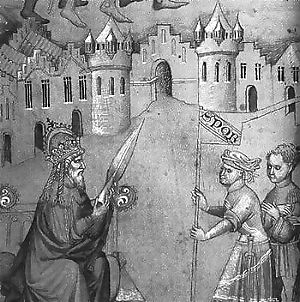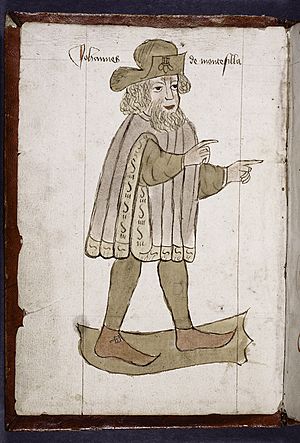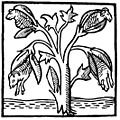John Mandeville facts for kids
Sir John Mandeville is the name of the person who supposedly wrote The Travels of Sir John Mandeville. This book is a travel story that first appeared between 1357 and 1371. The oldest version we have is in French.
This book became super popular because it was translated into many languages. Even though the travels it describes are often made up and unbelievable, people used it as a reference. For example, Christopher Columbus was greatly inspired by this book and by Marco Polo's earlier Travels.
Contents
Who Wrote the Book?
In the beginning of the book, the writer says he is a knight born in St Albans, England. But even though the book is real, most people believe that "Sir John Mandeville" himself was not a real person. Many experts think the real author was a Frenchman named Jehan à la Barbe.
Some newer ideas suggest that Mandeville's Travels was probably written by Jan de Langhe. He was a monk from Belgium who wrote in Latin and French. Jan de Langhe was born in Ypres in the early 1300s. By 1334, he became a monk at an abbey near Calais. He studied law and later became the head of his abbey in 1365. He wrote many books and loved collecting travel stories until he died in 1383.
Was There a Real Mandeville?
It seems that parts of Mandeville's Travels and the story of John Mandeville are made up. There is no clear proof from that time that a knight named Jehan de Mandeville actually existed. Some old French writings mention a letter from him to Edward III of England. But this letter is very general and could have been written by anyone.
Many believe the book was put together by a doctor from Liège, known as Johains à le Barbe or Jehan de Bourgogne. Evidence for this comes from an old story. In this story, "Jean de Bourgogne, called a la Barbe," supposedly told someone on his deathbed that he was "Lord Jean de Mandeville, knight." He said he was a count from England who had traveled the world.
The story adds that he had to travel because he accidentally killed a count in his home country. He arrived in Liège in 1343. He was known as a great scientist, thinker, and astrologer. He also knew a lot about medicine. This idea is supported by an old tombstone in Liège. It said that Mandeville was also called "ad Barbam," was a medicine professor, and died in Liège in 1372.
Even before he died, the Liège doctor seemed to admit he helped spread and add to the book. In one Latin version of the book, the author says he met a wise doctor in Cairo. Much later, in Liège, he wrote this book with the help of that same doctor.
In the last chapter, the author says that in 1355, he returned home and came to Liège. He was old and had gout. He saw doctors, and one wise old doctor named Magister Iohannes ad Barbam came in. They realized they had met before in Cairo. This doctor then strongly asked him to write his travels. The author says that with the doctor's advice and help, he wrote the book. He also mentions he was staying in Liège, which was close to England. The book was first published in French by Mandeville in 1355 in Liège. Soon after, it was translated into Latin there.
What the Book is About

The book says that John de Mandeville started his journey in 1322. He traveled through many places like Turkey, Tartary, Persia, Syria, Arabia, Egypt, Libya, Ethiopia, Chaldea, Amazonia, India, and many other countries around India. He claimed to have visited Jerusalem many times. He wrote his book in French because it was more widely understood than Latin at the time.
See also
 In Spanish: Juan de Mandeville para niños
In Spanish: Juan de Mandeville para niños
- Menocchio
Images for kids
-
Cotton plant as imagined and drawn by John Mandeville; "There grew there [India] a wonderful tree which bore tiny lambs on the endes of its branches. These branches were so pliable that they bent down to allow the lambs to feed when they are hungrie."




